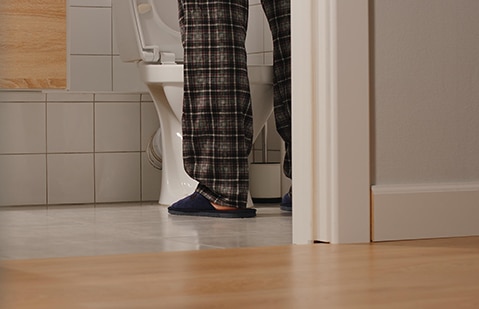Overactive Bladder Treatments: What’s Best for You?
February 21, 2024

Living with an overactive bladder is like trying to outrun an ocean wave. Sometimes the wave doesn’t catch you. But sometimes, it does.
Nearly one-third of Americans struggle with bladder control. If you’re among them, don’t be discouraged. There are many treatment options. Your MidLantic Urology physician can help you find the option that’s best for you. The first step is understanding why your bladder may not be working the way it should.
Why Does My Bladder Overact?
When you urinate, your sphincter relaxes, and then your bladder muscle contracts to push out the urine. Then the bladder muscles must relax so your bladder can fill again. If something has damaged or weakened your bladder muscle, it can affect your ability to control urination.
OAB symptoms can arise under the following circumstances:
- Certain medications, alcohol, and caffeine can dull or sometimes exaggerate the signals from your bladder to the brain.
- Obesity adds extra pressure on your bladder.
- Some diseases (such as Parkinson’s disease, multiple sclerosis, and stroke) cause changes in nerve signaling which can affect bladder control.
- Pregnancy and childbirth can lead to weakening of pelvic floor muscles, shifts in the anatomy of the bladder and urethra, and nerve damage.
- Radiation therapy may irritate or inflame the bladder.
- Urinary tract infection can make your bladder muscles overactive.
Is There a Test for OAB?
There are several tests that can confirm OAB and help determine the right treatment for you. Our urologists at MidLantic Urology may recommend one or more of the following:
- Urinalysis – This common test examines a sample of your urine.
- Urodynamics – This test measures pressure in your bladder and urine flow. This also includes measurement of how much urine remains in your bladder after you urinate.
- Cystoscopy – A thin, flexible scope with a tiny camera or a lens is inserted into your urethra to look for abnormalities.
What are My Treatment Options?
At MLU, we approach OAB treatment as a journey. The first step is your initial evaluation which includes a history, examination and diary for you to track what you drink and when you urinate. That information will determine which treatment may be best. We generally start by recommending the least invasive treatment, knowing that other options are available if something doesn’t work for you. These may include:
- Lifestyle changes, including diet modification, weight management, pelvic floor exercises (Kegels), and bladder training (biofeedback).
- Oral medications that relax your bladder muscle so you can hold more urine.
On follow up, we may prescribe an alternative medication if you’ve found no relief so far. We may also recommend some testing to better understand what may be causing your lack of bladder control.
There are many options if your OAB has not resolved. They include:
- Sacral nerve stimulation – We implant a tiny pacemaker-like device that calms the sacral nerve, which controls your bladder function. You can first test the therapy to see if it works for you.
- Botox – When injected directly into the bladder, Botox will partially paralyze the muscle to reduce overactivity. You’ll retain enough control to empty your bladder voluntarily.
- Tibial nerve stimulation – We insert a slim needle electrode to stimulate your tibial nerve which is located just above your ankle. These impulses travel to your sacral nerve for better bladder control.
If none of these approaches resolve your OAB, there are other options, including surgery. Our mission is to gradually get you back in control of your bladder so that in addition to relief, you gain a better awareness of your body. This will best ensure you proceed with comfort, and the confidence to eventually wave goodbye to OAB.
You can learn more about OAB here. Find a urologist in the Philadelphia region to treat your OAB here.

